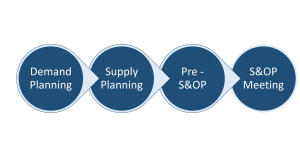9.7 Forecasting in the Supply Chain
Having delved into the intricacies of forecasting methods and their accuracy measures, it’s evident that when firms diligently adhere to the forecasting process and employ the right methods, they stand to benefit from higher product availability and optimized inventory levels. This balance is the hallmark of efficient operations. Yet, when we zoom out and consider the broader supply chain, a paradox emerges. Even if every entity within the supply chain forecasts independently and accurately, the system as a whole can still encounter significant disruptions. One such notorious disruption is the ‘Bullwhip Effect’. In this section, we’ll unravel the Bullwhip Effect, understand its origins, and explore strategies to mitigate its impact.
9.7.1 The Bullwhip Effect and Its Causes
The Bullwhip Effect is a phenomenon in supply chain management where order variances amplify as one moves upstream in the supply chain. Despite the average demand remaining consistent, the variability in demand escalates as we traverse from downstream to upstream entities. This means that while the end customer might experience the least variation in demand, the upstream suppliers face the most significant fluctuations. These amplified variations make forecasting increasingly challenging and inaccurate for entities farther from the end consumer.
Several factors contribute to the emergence of the Bullwhip Effect:
- Demand Forecasting Updates: Each entity in the supply chain makes forecasts based on the demand from its immediate downstream partner. Small errors or changes at the customer level can get magnified as they propagate upstream, leading to larger discrepancies in forecasts for suppliers.
- Order Batching: Companies might not order products continuously but in batches. This practice can introduce variations in order sizes and frequencies, further distorting the perceived demand.
- Price Fluctuations: Promotional discounts and other pricing strategies can lead to a surge in demand during the sale period and a subsequent drop afterward. These oscillations in ordering patterns can exacerbate the Bullwhip Effect.
- Shortage Gaming: In anticipation of stock shortages, retailers might order more than needed, expecting only partial fulfillment. This behavior sends inflated demand signals to the manufacturer.
The consequences of the Bullwhip Effect are multifaceted. The increased variability in demand, coupled with inaccurate forecasting, often results in reduced product availability for the end consumer. Simultaneously, upstream suppliers, grappling with these amplified fluctuations, might hold excessive inventory, leading to increased holding costs. The combined effect is a supply chain that’s both cost-inefficient and less responsive to the actual needs of the market.
Recognizing and understanding the causes and implications of the Bullwhip Effect is crucial for supply chain entities aiming to enhance coordination, reduce costs, and improve service levels.
9.7.2 Collaborative Planning, Forecasting, and Replenishment (CPFR)
CPFR is a collaborative approach where manufacturers and retailers work together to forecast and replenish inventory. In the retail industry, CPFR has been transformative. Instead of working in isolation, the manufacturer and retailer share tasks and responsibilities:
- Joint Business Planning: Both parties discuss and set mutual business goals and strategies.
- Sales Forecasting: Based on shared data, a joint sales forecast is developed.
- Order Forecasting: Predictions are made about upcoming orders based on the sales forecast.
- Inventory Replenishment: Inventory levels are adjusted based on the order forecast.
By sharing data and responsibilities, CPFR reduces the layers of distortion in demand information, minimizing the Bullwhip Effect. The result is a more synchronized supply chain, with better product availability and optimized inventory levels.
9.7.3 Sales and Operations Planning (S&OP)
Relating back to the silo effect discussed in Chapter 1, organizations often face challenges when different departments operate in isolation, not sharing crucial data. This lack of inter-departmental communication can severely hamper forecasting and planning. For instance, if the marketing department launches a promotion without informing the supply chain department, it can lead to stockouts.
S&OP is a coordinated approach to business planning that integrates sales, marketing, and supply chain functions. The process typically involves several phases:

- Demand Planning: Sales and marketing teams forecast demand based on historical data, market trends, and promotional activities.
- Supply Planning: The supply chain team assesses the resources (like materials and production capacity) needed to meet the forecasted demand.
- Pre S&OP: Cross-functional teams review and adjust the demand and supply plans, ensuring alignment.
- S&OP Meeting: Senior management reviews the consolidated plan, making final decisions on production, inventory, and procurement.
By fostering collaboration between departments, S&OP ensures that the entire organization is aligned in its objectives, leading to more accurate forecasts, better resource allocation, and improved customer service.
An example: Implementation of Forecasting in Inventory Management
Consider only two items A and B whose demand are shown below; note both items have random fluctuations only around more or less the same average.

- If you had a choice between managing items A and B which one would you choose? and why?
- Which of these two items will have a small MAD?
- For which item should we keep a high level of “safety stock” ?
- Is there a relationship between MAD and Safety Stock?